| 1 | Ruler of coral reefs |
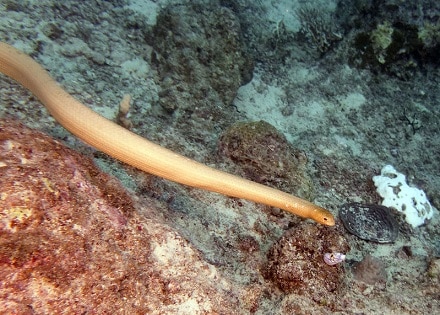
The banded sea krait is the sea snake which pops up on coastlines most often, spooking scuba divers minding their own business. The olive sea snake, meanwhile, is the snake most commonly found on coral reefs. It’s an incredibly easy snake to find, not one to lurk on a remote island and only appear every 30 years during a hurricane.
Olive sea snakes are constantly encountered by coral reef enthusiasts, swimming past determinedly on a mission to hunt for fish. They’re found all over the place, including Great Barrier Reef, Shark Bay, Timor Coast and also the isolated Ashmore Reef. Sometimes they can mysteriously be absent, but in other spots they can be incredibly abundant, reaching 0.70-0.86 snakes per meter. This is probably the single snake that a coral reef explorer is most likely to see.
Unlike banded sea kraits, olive sea snakes almost never stray to land, breeding, laying eggs and digesting meals underwater. Their preferred depths are 10-40m, straying up to 1 metre deep reef flats every so often. Upper lagoon slopes and lower reef edges are their favourites, and particularly larger reefs with plenty of shelter. The maximum depths they reach are 70m.
| 2 | They love you |
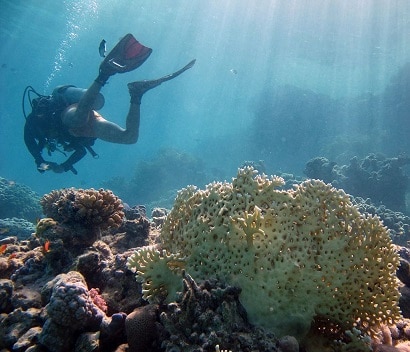
Olive sea snakes usually ignore reef explorers, but they have a reputation for occasionally approaching with unusual focus and determination and wrapping themselves around a leg. Now scientists have an explanation: that excited male snakes are mistaking divers for the females they’re hoping to breed with. A 2021 study found that most of these approaches happened in the breeding season, and that very few of the snakes were female.
Rather than the relaxed, ambling swim of a curious snake, the aggressive snakes swam in the telltale zigzag pattern, the same they use to pursue a lady snake. Tellingly, many had been following a fleeing female and lost her just before switching focus to the confused diver. Wrapping around the leg is also a signature mating move for the species, except that it’s normally a female’s entire body.
Apparently, sea snakes are much more likely to make this mistake, as the pheromone lipids they use for attraction dissolve poorly in water. Males rely heavily on visuals to find mates, a plan which sometimes malfunctions. If an olive sea snake comes charging in a zigzag pattern, then rest assured that it’s all love.
| 3 | A calm-looking snake |
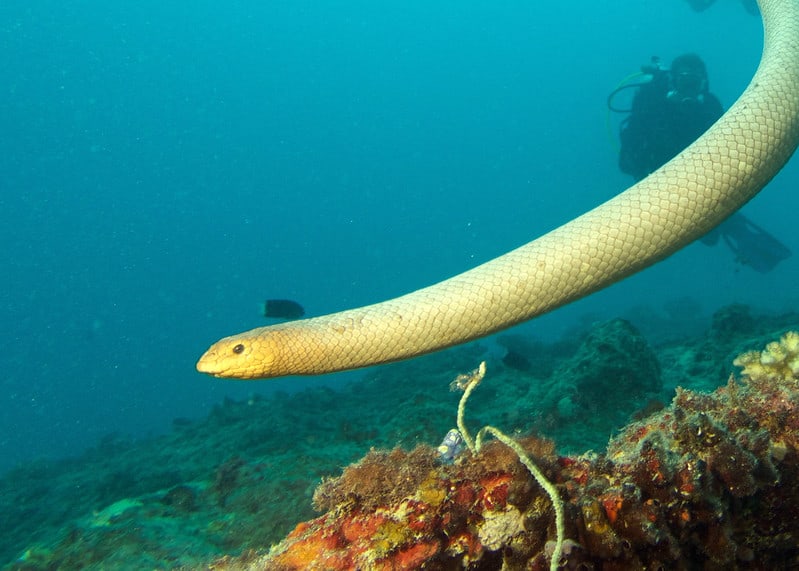
Up close, the olive sea snake looks much less vicious than the average cobra. Rather than a reptilian snarl, it has small round eyes and a smooth face that give it a humble and calm appearance. The pattern of its scales look like honeycomb, or a parched and cracked soil in summer. The scales are very smooth, and the laevis part of the scientific name (aipysurus laevis) even derives from the Latin word for smooth (levis).
As younglings, olive sea snakes have pale rings on their bodies which quickly disappear when they reach adulthood. Their colour also lightens, switching from brown to a creamy-olive colour. The backs of adults have purple coloured scales, while their bellies tend to be white.
Banded sea kraits have a compressed tail whose flatness allows them to paddle, but with olive sea snakes this covers even more of their bodies. Almost the entire lower third is compressed and flat, to swash water aside as they swim forward. Their mid-section, meanwhile, is particularly thick for a sea snake. Their facial expressions might be docile and amiable, but aipysurus laevis is a powerful snake.
| 4 | Eaten by tiger sharks |
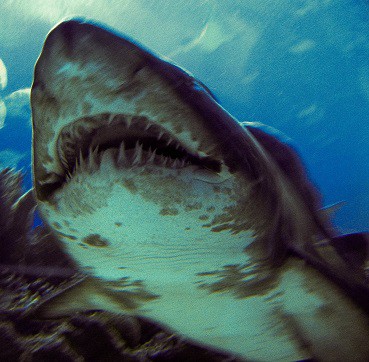
A nature question that never gets old is wondering which species a shark could win against. They’ve been pitted against bears, rhinos and even T-rexes in hypothetical duels, and others have wondered whether sharks are secretly too scared to eat the many venomous sea snakes they share habitats with. A study on sharks washed up in Queensland finally answered people’s questions, analysing 7000 individual sharks across 19 species.
Only 6 species had sea snakes in their stomachs, and mostly in tiny numbers. There was plenty of fish, even the odd turtle, but few snakes. All except for one species: the tiger shark. This reef-prowling species has proven resistance to sea snake venom, and one dead individual had 4 sea snakes in its stomach.
Across various locations, 5-33% of tiger sharks had sea snakes in their stomachs. But most importantly, an older 1982 study found that the olive sea snake was the main species hunted, alongside the banded sea krait. A study from Japan confirmed that tiger sharks were by far the keenest on eating sea snakes.
| 5 | Their tails can sense light |
Being preyed on by sharks seems to have put the evolutionary pressure on this snake. In 2019, scientists used RNA sequencing and discovered that the olive sea snake’s tail was covered with hidden light receptor genes. These included genes normally found in the retina of the eye, with one encoding a light sensitive protein called melanopsin. The end result was that the snake’s tail could “see” without actually seeing, responding to light changes.
The big theory was that this helps them to sense predators like sharks or sea eagles. Shining a light on the tail caused the snake to slither to shelter, but the tail might equally respond to reduced light, like the shadow of a tiger shark several metres up. It could also protect the snake when probing into dark rock crevices for prey, which leaves their tails massively overexposed.
The olive sea snake was the only reptile of over 10,000 tested to have these light responding powers on the tail. The researchers then tested 8 sea snake species, but found light sensing tails in just 3, all from the same Aipysurus family.
| 6 | Guaranteed to attack if… |

If you come across an olive sea snake while on holiday at Great Barrier Reef, then we have one recommendation: don’t kneel on them! Some snakes like the Russell’s viper can stand being stood on and not even budge, but not this snake. Normally, olive sea snakes have no interest in biting divers, not even when they’re curled around their legs in a misidentified haze of love. Swimming past them while sheltering in coral reefs is no problem, and in general, they’re not defensive minded.
The one thing they hate though, is being restrained in any way. Almost all bites happen when people grab the snake out of curiosity and impede its ability to swim away, including accidental kneelings. Striking this snake with a flipper is also a big no-no.
Another rule: never, ever interrupt this snake while it’s courting females. This really annoys them, for whatever reason, and sends them flying towards the intruder at full speed with fangs bared. The olive sea snake has sharp fangs measuring 7mm, which may not be apparent until it’s too late.
| 7 | Eats many types of fish |
Olive sea snakes have a much less fussy diet compared to the eel-addicted banded sea krait. Eels are on their vast, vast menu, but so are snappers, shrimps, and catfish. Specific species they hunt include big-eye snappers (lutjanus lutjanus), striped eel catfish (plotosus lineatus), and common bluestripe snapper (lutjanus kasmira).
Underwater scientists lurking in coral reefs managed to spot their hunting methods in action. The olive sea snake strikes at its prey at a 30-60 degree angle relative to its direction of travel. It grips the fish tightly in its jaws, and waits for just a few seconds before rearranging it to be swallowed headfirst. The venom has an LD50 rating of 0.22mg in humans (versus 0.4mg for a banded sea krait), already one of the deadliest species on Earth, but in fish the venom is so powerful that they die instantly.
Anything moving and bright-coloured tends to catch the attention of this snake. The olive sea snake also couldn’t care less about gulping down clouds of sediment along with its prey.
| 8 | Patient, yet relentless hunter |
Firstly though, they have to find the fish, and their main strategy is the time-tested one of crevice investigation. They simply spot a dark crevice in the coral reef where a fish may lurk, and poke their heads in to flush them out. But the interesting thing about this species is how diligent and industrious they are.
This snake prefers the vertical edges of coral reefs for foraging rather than the face. Firstly, they select a spot on the edge, then explore all the nearby crevices from the root of that spot, with their tongue constantly flecking. Once they’re done, they’ll move to a new spot 1 metre to several metres away, and repeat the exact process. They continue this relentlessly, moving further along the reef edge, like a metal detector searching every square meter for treasure.
Occasionally, they’ll even double back and check a crevice they’ve already investigated. By day, olive sea snakes move an average of 2.7 metres a minute while foraging, and at night the figure is barely any different at 2.77 metres. A second strategy is to hide amongst schools of fish which they’re not particularly interested in, like trumpet fish, and strike other species as they absentmindedly swim past.
| 9 | Clockwork breathing cycle |
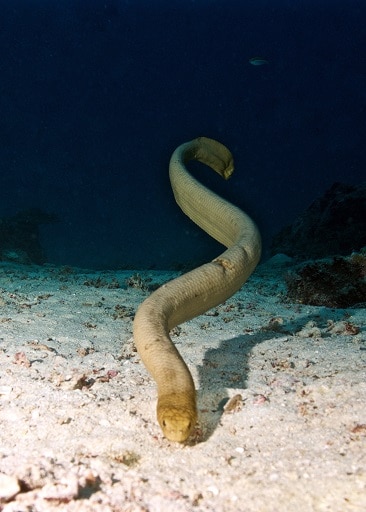
Something a good olive sea snake can never forget to do is breathe. Otherwise, they’ll die. Olive sea snakes have the adaptions of normal sea snakes: an enlarged saccular lung that extends further down their bodies, and semi-circular nostrils which close shut like a valve to keep out water. But they still need oxygen like any dry land creature, and are sometimes forced to surface in the midst of foraging.
Scientists have observed that once they make the decision, they suddenly float upwards at rates of 1 metre per minute. At the surface, they take no more than 1-3 breaths before plunging back down again, spending just a few seconds on the stormy/sunny sea surface. Over many hours, the scientists found that the average breath hold cycle lasted for 15.9 minutes (while hunting at least).
When not foraging, olive sea snakes tend to be shy and bunker down in sheltered spots within the reef. They have very small home ranges of just 2 kilometres, but lack a particular base within each reef that they return to (unlike the smooth snake). The banded sea krait can return to a home base 5.3km away within 31 days after being dumped on nearby islands, but the olive sea snake lacks this homing power, or doesn’t care to use it. When moved to a separate reef, they never attempt the epic voyage home, and adapt to their cosy new reef quickly.
| 10 | Prawn trawler danger |
Olive sea snakes aren’t close to endangered across their vast range, but industrial prawn trawlers are perhaps the biggest threat they face. The average fishing boat can scoop them up as well, but prawn trawlers operate at very similar underwater depths to sea snakes, including our olive friend. From 1992 to 1995, 11% of sea snakes caught in the Great Barrier Reef as prawn trawler bycatch were olive sea snakes. The figure was healthier in the Timor Sea, at 7%, but in 1998, 18% of sea snakes accidentally caught in the northern Australian continental shelf were aipysurus laevis.
Olive sea snakes are particularly unlikely to survive as well. 50% are killed, and the rest suffer severe injuries. The metallic mechanisms can tear their skin, or their bodies can be crushed by the mounting weight of fish above. The most horrific is drowning, as once an olive sea snake is caught, they’re helpless while the machine continues to plough forward underwater. Being caught alongside spiny or poisonous sea creatures is another danger.
The saving grace is that prawn trawlers only operate in a small portion of olive sea snake territory. The species’ range is simply way too large to conquer.